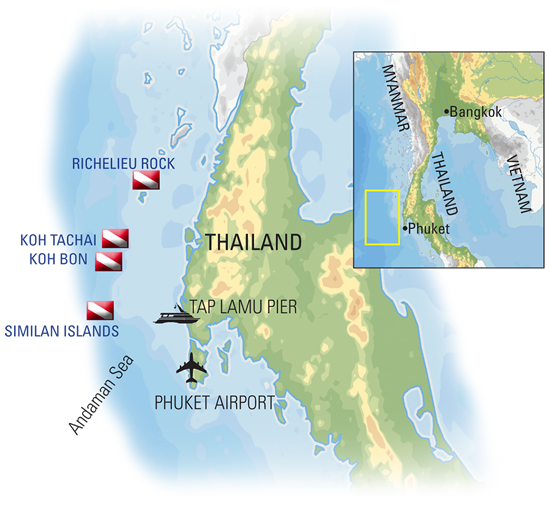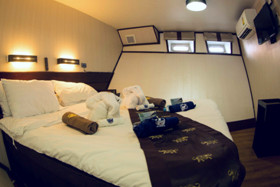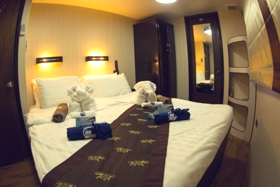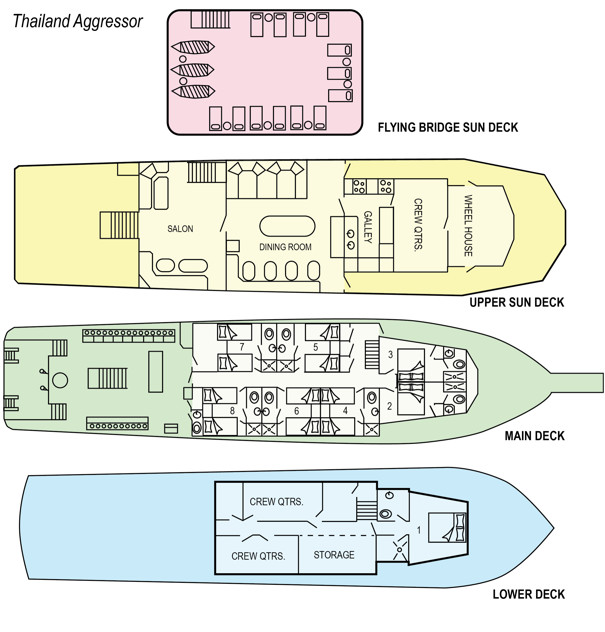
Thailand Aggressor - North Andaman Sea
8 Night Trips - (Saturday - Saturday)

Thailand Aggressor - North Andaman Sea
8 Night Trips - (Saturday - Saturday)

Thailand Aggressor - North Andaman Sea
8 Night Trips - (Saturday - Saturday)
-
About


-
Itineraries & Dive Map


-
Know Before You Go


-
Yacht Specs


-
Weeks & Rates


-
Special Rates for these Weeks


Thailand is known as "The Land of Smiles" for its warm and friendly people. This island paradise lies only 8 degrees north of the equator and enjoys a tropical climate year round. For divers, the true treasures of the Andaman Sea are found at famous sites in areas such as the Similan Islands and Richelieu Rock, where the warm, clear water draws large schools of tropical fish, manta rays, and the awe-inspiring whale shark. The wealth of aquatic life will delight underwater photographers and marine naturalists when scuba diving from a liveaboard boat in Thailand.
The THAILAND AGGRESSOR™ itinerary, the Andaman Sea (North) offers the best diving in Thailand and charters from Saturday - Saturday (7 night charters).
Getting There, Passports & Visa Documentation:
The island of Phuket lies in the Andaman Sea off the south west coast of Thailand in the geographic region of Mainland Southeast Asia. Phuket is separated from the mainland by a channel at its northernmost point, where the Sarasin Bridge connects the island to the mainland. Countries bordering Thailand are Malaysia, Burma, Cambodia and Laos.
The Phuket International Airport (HKT) is in the north of the island, and is Thailand's second largest hub to Bangkok. This is the airport guests will fly into when doing the Andaman Sea Thailand scuba diving itinerary. There are numerous connecting flights from the United States, Canada, Europe, Russia and Australia offering daily service to Phuket via Bangkok, alternate direct flights from Dubai, Hong Kong and Seoul to Phuket. Airlines offering service are Korean Air, Qatar Airways, Emirates, Thai Airways, Asiana Airlines and Malaysia Airlines.
Visitors must have a current passport, adequate funds to support themselves, and a return airline ticket. US citizens require a passport that must be valid for 6 months from date of entry. It is the travelers’ responsibility to ensure they have the proper visa to travel into each country on his or her itinerary as well as for re-entry and return to their country. Since regulations vary by country, contact your consulate or embassy of your country for the requirement.
NEW REQUIREMENTS: New requirements imposed by the Thailand National Park requires the following information at least 14 days prior to the boarding date of the Thailand Aggressor so the necessary permits can be approved. Failure to do so may result in guests not being able to dive:
Full name (must match passport). Date of Birth. Passport Nationality. Passport Number
Arrival/Boarding/Departure:
We highly suggest arriving a few days early and visiting Bangkok before the Thailand liveaboard scuba diving trip. Transfers are free of charge on the charter arrival/departure dates at the following pick up points
Charter Start Date From Tap Lamu Pier:
- Saturday 4 pm Phuket International Airport (HKT) for transfer to Tap Lamu Pier.
- Saturday 4-4:45 pm Kantary Beach Hotel and Villas, located in the Khao Lak beach region to Tap Lamu Pier.
Charter End Date From Tap Lamu Pier:
- Saturday 8 am departure to Phuket International Airport (HKT).
- Saturday 8 am departure to host hotels.
Guests arriving at the Phuket (HKT) International Airport on the day of the charter and the host hotels will be met at the above times by a THAILAND AGGRESSOR™ representative. If you are already on island, you may make your own way to the THAILAND AGGRESSOR™ liveaboard docked at Tap Lamu Pier for a 5-6 pm boarding or, you may meet at one of the above pick up points.
(7 Day advance notification is required for transfer arrangements)
Docking:
The THAILAND AGGRESSOR® departs for scuba diving from Tap Lamu Pier, which is located 1 - 1 1/2 hours north from the Phuket International Airport (HKT) on the mainland and just south of Khao Lak, a beautiful hilly mountainous region and tourist area. It is easily accessible from Phuket Island by road transport.
The Thailand liveaboard yacht departs from port Saturday evening for its first night anchorage to prepare for scuba diving the next morning. The yacht will arrive back to the pier Friday afternoon/early evening. The crew will host a cocktail party then dinner will be served onboard.

The Similan Islands lie approximately 100 km Northwest of Phuket, Thailand. Declared a National Park in 1982, the Similans are comprised of 9 islands, which run roughly North to South with numerous smaller rock outcroppings. With snow-white beaches, lush tropical jungle and spectacular dive sites in stunning turquoise waters, it's not surprising that the Similans are ranked as one of the top 10 dive sites in the world! Thailand LiveAboard diving is some of the best diving in the world.
Nearly all of the 9 islands are surrounded by huge underwater rock formations, eroded by the action of a relentless sea. These stone giants are home to an amazing variety of marine life, with depths often reaching 40 meters or more. Narrow swim-thru's, caverns and underwater canyons form a truly unique diving landscape. With names like 'Elephant Head', 'Boulder City', 'Sharkfin Reef' and 'East of Eden', you'll soon appreciate why the Similans deserve the reputation they've obtained.
Koh Bon and Koh Tachai
Are two uninhabited islands, situated between the Similans and Surin National Park to the North of the Similans. They offer a variety of excellent dive sites - including a breathtaking drop-off - with a wealth of hard and soft corals, and great opportunities to see passing manta rays and whale sharks.
Richelieu Rock
The best dive site in Thailand, lies Northeast of Ko Tachai, close to the southern border of Burma. This small rocky outcrop is covered in soft corals and offers an amazing variety of marine life, with the chance to see Stingrays, Guitar Rays, Leopard Sharks and large schools of Trevallies and Barracudas.
And best of all, Richelieu Rock is a ‘magnet’ for Whale Sharks and ranks among the world’s best places to observe these gentle giants. Close encounters with two or three whale sharks are fairly common, making this site a unique experience for any diver.
North Andaman Dive Sites
Similan - Bon - Richeliu + Surin - Richeliu - Similan
Anita's Reef - Barracuda’s Point, “Hin Muan Deaw”
The Thai name for this spectacular rock is “Hin Muan Deaw” and is the best way to describe how beautiful this rock really is, as it directly translates to “Whole roll (of film) rock”, as one can use an entire roll film solely on this rock. The reef slope falls from the reef flat at 15 – 35 ft (5 – 10 m) to the sand bottom at a maximum of 85 – 90 ft (26 - 28 m). Shallow coral gardens comprise huge pore and staghorn corals with small pinnacles. A big outcrop located on the southeast makes this dive site unique and attracts many photographers. Colorful soft corals, gigantic sea fans, and many species of hard corals surround this fantastic rock.
West of Eden
West of Eden basically comprises giant granite boulders that create nice canyons, with walls covered with colorful soft corals and giant sea fans. Some areas are characterized by rubble and sand slope falling to a depth of 100 – 115ft (30 - 35 m). The shallows are home to many reef fishes, and have stacked granite boulders covered with hard corals, soft corals, gorgonians and feather stars. This area is a nice place to look for macro subjects like nudibranchs and frogfish. Keep an eye out for cleaner pipefish and many banded pipefish in small crevices, as well as long-nose hawkfish perched in black coral bushes. The rubble and sand slope are good place to search for ribbon eels, dragonets and red fire gobies. Back at the reef, moray eels are quite common, as well as turtles and schools of angelfish. Occasionally, whitetip reef sharks cruise by.
Bon - Koh Bon West Ridge, Koh Talu
The wall, part of the Similan National Park, is decorated with various colorful soft corals and hard corals. From the ridge to the northeastern side are reefs that stretch along island. The reef slopes from a depth of 30 ft (10 m) down to a sandy bottom at 80 – 100 ft (25 - 30 m). The majority of corals here are hard corals, including staghorn coral and brain coral that are interspersed with a few big coral heads. To the northwest of the island, there is a submerged pinnacle. The pinnacle is at a depth of 60 – 150 ft (18 - 45 m) and is covered by an abundance of yellow soft corals and large sea fans. This site is a cleaning station for manta rays, so there is a high chance of finding at least one during a dive, particularly at the western ridge and northeastern outer reef. Koh Bon also has many kinds of sharks, such as leopard sharks and whitetip and blacktip reef sharks. Sometimes grey reef sharks swim by, and nurse sharks can be seen lying under coral heads. Schools of yellowtail barracuda, fusiliers, trevally, sweetlips and black and white snappers are all common in the area, as well as octopuses, sea snakes, and nudibranchs.
Tachi Reef – Leopard Shark Reef
Tachai Reef stretches through the eastern side of the island, going from the northeast to the southwest. The reef slope falls from 16 – 33 ft (5 - 10 m) to the sand floor at 82 – 98 ft (25 - 30 m). Hard corals cover the entire area, most of which are staghorn corals, pore corals, brain corals, and fire corals. In the southern part, the gentle slope becomes a steep drop-off that continues from the island down to 98 ft (30 m). Divers regularly see leopard sharks lying at the outer sandy area and sometimes in shallow areas. Large stingrays are found on occasion too. General reef fish include pufferfish, lionfish, parrotfish, and moray eels. At night, several species of crabs and shrimp come out to hunt. It is possible to see twin-spotted lionfish, a rare species of lionfish that tends to be shy and hide in crevices. Cuttlefish, nudibranchs and flatworm are also common
Richelieu Rock – Hin Plo Naam
One of the most famous dive sites of Thailand, Richelieu Rock is an isolated pinnacle to the east of Surin Islands. Forming a horseshoe figure, the pinnacle fall steeply to the surrounding sand bottom at a maximum depth of 115 ft (35 m). The south side is a bay with a slope that gently falls to the deep, while the rest comprises sheer walls, groups of rock and numerous small caves that are home to various marine life. The majority of corals are colorful soft corals jostling against the wall, accompanied by huge sea fans, hard corals and sea anemones.
Due to the diversity of small and large creatures, Richelieu Rock is a paradise for underwater photographers. Ghost pipefish, frogfish, harlequin shrimp, seahorses, Janss pipefish are some of the smaller marine life that can be spotted here. Also, divers have often encountered cuttlefish mating. In addition, plenty of anemone fish species, particularly tomato clownfish, are regularly sighted. Different types of moray eels such as giant moray, zebra moray, and white-eyed moray are common. Pelagic fish swarming around the small outcrops include chevron barracuda, rainbow runners, and giant groupers resting on the sand floor are a common sight. Lastly, this site is famous in Thailand for being a hotspot for encounters with both whale sharks and manta rays.
Tachi Pinnacle – Twin Peaks
A solitary island located 20 km. north of Koh Bon, Koh Tachai has magnificent white sandy beaches with two interesting dive spots, southern pinnacles and eastern reef. Tachai Pinnacle or Twin Peaks are a pair of submerged pinnacles located 500 m south of Koh Tachai. The southern pinnacle is bigger, at a depth of 40 ft (12 m) from the top. It is a dome shape surrounded by large boulders. The sand bottom is at a depth of around 100 – 150 ft (30 - 45 m). To the west you will find large boulders, some of which have formed swim throughs. In the east, you will find stacks of small rock, most of which are cover by hard corals and sea whips. Colorful soft corals and sea fans dominate the northern area. The top of the pinnacle is a wide flat plain with bush and mountain coral. This huge pinnacle links to the small one with a sand patch at 80 ft (24 m). The smaller pinnacle comprises of a wide range of rock clusters and is home to large sea fans and corals, which are similar to the ones found in the southern pinnacle.
Manta rays visit this area for feeding and circling around the pinnacles. Some divers have encountered whale sharks as well. On the outer sand bed, divers can usually see leopard sharks, sometime three to four of them in the same dive. In addition, it is possible to find Jenkin’s rays, as well as whitetip sharks and blacktip reef sharks here as well. Swarm of chevron barracuda, bluefin trevally, batfish, snappers, and fusiliers are common here.
Elephant Head Rock - Hin Pusa, Hin Hua-ka-loak
Visible from the surface, Elephant Head Rock is the biggest pinnacle in the Similans. It is located 1.5 km south of Koh Similan. There are three large boulders that emerge above water. At this site, submerged boulders are piled up, forming sheer walls and swim-throughs that are covered with assorted colors of soft corals and sea fans. The site is surrounded by sand at a maximum depth of 115 – 130 ft (35 to 40 m).
One of the outstanding features of this site is the swim-throughs. In addition, cave walls are full of soft corals, creating plenty of magnificent scenery that makes you feel like you are swimming in an underwater valley. To the west of the giant rock is a sheer wall that falls to a depth of 130 ft (40 m). Divers have often seen whitetip and blacktip reef sharks outside the boulders. In addition, juvenile whitetip reef sharks can sometime be seen laying in the cracks of the boulders. In mid-water, schools of fish, including bluefin trevally, fusiliers and rainbow runners are common. Near the exposed boulders, giant trevally and great barracuda are a common sight. Also, divers may encounter large snappers and sweetlips in cracks, holes and swim-throughs.
Christmas Point
A cluster of submerged boulders, with the exception of a pinnacle at the surface that is located on the northwest ridge of Koh Ba-Ngu. Underwater, there are number of large stacked boulders that stretch from the island to a depth of 115 – 130 ft (35 - 40 m), which create an arch like swim-throughs at 80 ft (24 m). Colorful soft corals and sea fans cover the crevices. A hard coral garden made up of rows of staghorn and pore coral is located at a shallow depth of 30 ft (10 m).
Around the borders of the rocks and beyond, at a depth of 80 – 130 ft (25 - 40 m), you are likely to find leopard sharks, whitetip and blacktip reef sharks and other big fish such as Napoleon wrasse, great barracuda, giant trevally and tunas. At the swim-throughs, giant sweetlips and groupers can be seen hiding in crevices. School of fish including bluefin trevally, neon fusiliers, goatfish, and long nosed emperors are frequent visitors. Many small fish, such as purple fire gobies and red fire gobies are a familiar sight here. Ribbon eels, a rare species that camouflages on the sand like whip corals, can also be seen. Also, pipefish, nudibranchs, and porcelain crabs cab be found. It is possible to spot manta rays passing by as well.
Shark Fin Reef - Hin Phae, San cha-larm
A formation of granite boulders and hard corals to the southeast of Koh Pa-Yan. The site itself is approximately 1 km. long and lies from the northwest to the southeast. Normally three pinnacles can be seen from the surface, which gives the reef its name Shark Fin Reef. Boulders that fall steeply to 115 – 130 ft (35-40 m) and are surrounded by sand occupy the vast majority of the site. Due to the fact that the boulder formation is long, coral reefs have been divided into northern and southern areas. Both areas are steep and cliff-like. The northern area has more corals consisting mostly of staghorn coral and soft corals, combined with tiny rocks and sea fans. The southern side is made up primarily of sheer walls. Overall, at various parts of the reef, some pinnacles have stacked themselves on top of one another, forming many swim-throughs that divers can enjoy.
Near the sandy areas, you likely to find leopard sharks, whitetip and blacktip reef sharks, Kuhl’s stingrays and spotted garden eels. Furthermore, this site is one of the few areas in the Similans where you can see Napoleon wrasse and hump head parrotfish. Bigger than usual adult cube boxfish are often seen, particularly in the shallow waters of the east. Among the boulders, a lot of camouflaged marine life can be seen, including octopuses and devil scorpionfish. Manta rays can be spotted during the month of April and whale sharks have been report in the vicinity as well.

Master Stateroom (# 1)
Located on the lower Dolphin Deck, this cabin has a Queen Bed, Private Facilities with Bathtub and Portlight Views, Mirrored Cabinet, Wardrobe, Hairdryer, Bathrobes, Toiletries, Fresh Towels Daily, Independent Air Conditioning and Volume Controls and Monitor with Media Player.

Master Stateroom (# 2, 3)
Queen Bed, Private Facilities with Bathtub, Picture Window View, Mirrored Cabinet, Wardrobe, Bathrobes, Hairdryer, Toiletries, Fresh Towels Daily, Independent Air Conditioning and Volume Controls and Monitor with Media Player.

Deluxe Stateroom (# 6, 7, 8))
Two Twin Beds (combinable), Private Facilities, Picture Window View, Mirrored Cabinet, Wardrobe, Bathrobes, Hairdryer, Toiletries, Fresh Towels Daily, Independent Air Conditioning and Volume Controls and Monitor with Media Player.

Deluxe Stateroom (# 4, 5)
Two Twin Beds (combinable), Private Facilities, Picture Window View, Mirrored Cabinet, Wardrobe, Bathrobes, Hairdryer, Toiletries, Fresh Towels Daily, Independent Air Conditioning and Volume Controls and Monitor with Media Player.

The Yacht
Port: Taplamu Pier
Built and maintained to the specifications of the local regulatory agencies and the regulations of the country of the flag.
• Length: 115 ft.
• Beam: 23
• Passengers: 16
• Staterooms: 8
• Staff: 8
• 7 night trips
• Boarding: Check the Know Before You Go depending on itinerary
• Check out: Check the Know Before You Go depending on itinerary
Thailand Aggressor has been an Aggressor destination since March, 2013.
Staterooms
Room #1 Master Stateroom
Rm Size: 11'6" x 9'6" feet
Queen: 60 x 80 inches
Room #2 Master Stateroom<
Rm Size: 8'6" x 11'6" feet
Queen: 60 x 80 inches
Room #3 Master Stateroom
Rm Size: 8'6" x 11'6" feet
Queen: 60 x 80 inches
Room #4 Deluxe Stateroom
Rm Size: 8'6" x 9'6" feet
Twin: 48 x 73 inches
Twin: 48 x 73 inches
Room #5 Deluxe Stateroom
Rm Size: 8'6" x 9'6" feet
Twin: 48 x 73 inches
Twin: 48 x 73 inches
Room #6 Deluxe Stateroom
Rm Size: 8'6" x 9'6" feet
Twin: 35 x 80 inches
Twin: 35 x 80 inches
Room #7 Deluxe Stateroom
Rm Size: 8'6" x 9'6" feet
Twin: 35 x 80 inches
Twin: 35 x 80 inches
Room #8 Deluxe Stateroom
Rm Size: 8'6" x 9'6" feet
Twin: 35 x 80 inches
Twin: 35 x 80 inches
| Vessel | Embarkation | Disembarkation | Nights | Berths | Port | Itinerary | Destination | Embarkment | Disembarkment | Special Rate |
| Thailand Aggressor | 10/31/20 | 11/07/20 | 7 | 10 | North Andaman Sea | North Andaman Sea | North Andaman | Taplamu Pier | Taplamu Pier | $ 3290 |
| Thailand Aggressor | 11/07/20 | 11/14/20 | 7 | 10 | North Andaman Sea | North Andaman Sea | North Andaman | Taplamu Pier | Taplamu Pier | $ 3290 |
| Thailand Aggressor | 11/14/20 | 11/21/20 | 7 | 2 | North Andaman Sea | North Andaman Sea | North Andaman | Taplamu Pier | Taplamu Pier | $ 3290 |
| Thailand Aggressor | 11/21/20 | 11/28/20 | 7 | 16 | North Andaman Sea | North Andaman Sea | North Andaman | Taplamu Pier | Taplamu Pier | $ 3290 |
| Thailand Aggressor | 11/28/20 | 12/05/20 | 7 | 12 | North Andaman Sea | North Andaman Sea | North Andaman | Taplamu Pier | Taplamu Pier | $ 3290 |
| Thailand Aggressor | 12/05/20 | 12/12/20 | 7 | 11 | North Andaman Sea | North Andaman Sea | North Andaman | Taplamu Pier | Taplamu Pier | $ 3290 |
| Thailand Aggressor | 12/12/20 | 12/19/20 | 7 | 16 | North Andaman Sea | North Andaman Sea | North Andaman | Taplamu Pier | Taplamu Pier | $ 3290 |
| Thailand Aggressor | 12/19/20 | 12/26/20 | 7 | 16 | North Andaman Sea | North Andaman Sea | North Andaman | Taplamu Pier | Taplamu Pier | $ 3290 |
| Thailand Aggressor | 01/02/21 | 01/09/21 | 7 | 12 | North Andaman Sea | North Andaman Sea | North Andaman | Taplamu Pier | Taplamu Pier | $ 3290 |
| Thailand Aggressor | 01/09/21 | 01/16/21 | 7 | 16 | North Andaman Sea | North Andaman Sea | North Andaman | Taplamu Pier | Taplamu Pier | $ 3290 |
| Thailand Aggressor | 01/23/21 | 01/30/21 | 7 | 16 | North Andaman Sea | North Andaman Sea | North Andaman | Taplamu Pier | Taplamu Pier | $ 3290 |
| Thailand Aggressor | 01/30/21 | 02/06/21 | 7 | 16 | North Andaman Sea | North Andaman Sea | North Andaman | Taplamu Pier | Taplamu Pier | $ 3290 |
| Thailand Aggressor | 02/13/21 | 02/20/21 | 7 | 16 | North Andaman Sea | North Andaman Sea | North Andaman | Taplamu Pier | Taplamu Pier | $ 3290 |
| Thailand Aggressor | 02/20/21 | 02/27/21 | 7 | 13 | North Andaman Sea | North Andaman Sea | North Andaman | Taplamu Pier | Taplamu Pier | $ 3290 |
| Thailand Aggressor | 02/27/21 | 03/06/21 | 7 | 16 | North Andaman Sea | North Andaman Sea | North Andaman | Taplamu Pier | Taplamu Pier | $ 3290 |
| Thailand Aggressor | 03/20/21 | 03/27/21 | 7 | 14 | North Andaman Sea | North Andaman Sea | North Andaman | Taplamu Pier | Taplamu Pier | $ 3290 |
| Thailand Aggressor | 03/27/21 | 04/03/21 | 7 | 16 | North Andaman Sea | North Andaman Sea | North Andaman | Taplamu Pier | Taplamu Pier | $ 3290 |
| Thailand Aggressor | 04/03/21 | 04/10/21 | 7 | 16 | North Andaman Sea | North Andaman Sea | North Andaman | Taplamu Pier | Taplamu Pier | $ 3290 |
| Thailand Aggressor | 04/10/21 | 04/17/21 | 7 | 16 | North Andaman Sea | North Andaman Sea | North Andaman | Taplamu Pier | Taplamu Pier | $ 3290 |
| Thailand Aggressor | 04/17/21 | 04/24/21 | 7 | 8 | North Andaman Sea | North Andaman Sea | North Andaman | Taplamu Pier | Taplamu Pier | $ 3290 |
| Thailand Aggressor | 10/30/21 | 11/06/21 | 7 | 16 | North Andaman Sea | North Andaman Sea | North Andaman | Taplamu Pier | Taplamu Pier | $ 2980 |
| Thailand Aggressor | 11/06/21 | 11/13/21 | 7 | 16 | North Andaman Sea | North Andaman Sea | North Andaman | Taplamu Pier | Taplamu Pier | $ 3290 |
| Thailand Aggressor | 11/13/21 | 11/20/21 | 7 | 16 | North Andaman Sea | North Andaman Sea | North Andaman | Taplamu Pier | Taplamu Pier | $ 3290 |
| Thailand Aggressor | 11/20/21 | 11/27/21 | 7 | 16 | North Andaman Sea | North Andaman Sea | North Andaman | Taplamu Pier | Taplamu Pier | $ 3290 |
| Thailand Aggressor | 11/27/21 | 12/04/21 | 7 | 16 | North Andaman Sea | North Andaman Sea | North Andaman | Taplamu Pier | Taplamu Pier | $ 3290 |
| Thailand Aggressor | 12/04/21 | 12/11/21 | 7 | 16 | North Andaman Sea | North Andaman Sea | North Andaman | Taplamu Pier | Taplamu Pier | $ 3290 |
| Thailand Aggressor | 12/11/21 | 12/18/21 | 7 | 16 | North Andaman Sea | North Andaman Sea | North Andaman | Taplamu Pier | Taplamu Pier | $ 3290 |
| Thailand Aggressor | 12/18/21 | 12/25/21 | 7 | 16 | North Andaman Sea | North Andaman Sea | North Andaman | Taplamu Pier | Taplamu Pier | $ 3290 |
| Thailand Aggressor | 12/25/21 | 01/01/22 | 7 | 14 | North Andaman Sea | North Andaman Sea | North Andaman | Taplamu Pier | Taplamu Pier | $ 3290 |
| Thailand Aggressor | 01/01/22 | 01/08/22 | 7 | 16 | North Andaman Sea | North Andaman Sea | North Andaman | Taplamu Pier | Taplamu Pier | $ 3290 |
| Thailand Aggressor | 01/08/22 | 01/15/22 | 7 | 16 | North Andaman Sea | North Andaman Sea | North Andaman | Taplamu Pier | Taplamu Pier | $ 3290 |
| Thailand Aggressor | 01/15/22 | 01/22/22 | 7 | 16 | North Andaman Sea | North Andaman Sea | North Andaman | Taplamu Pier | Taplamu Pier | $ 3290 |
| Thailand Aggressor | 01/22/22 | 01/29/22 | 7 | 16 | North Andaman Sea | North Andaman Sea | North Andaman | Taplamu Pier | Taplamu Pier | $ 3290 |
| Thailand Aggressor | 01/29/22 | 02/05/22 | 7 | 16 | North Andaman Sea | North Andaman Sea | North Andaman | Taplamu Pier | Taplamu Pier | $ 3290 |
| Thailand Aggressor | 02/05/22 | 02/12/22 | 7 | 16 | North Andaman Sea | North Andaman Sea | North Andaman | Taplamu Pier | Taplamu Pier | $ 3290 |
| Thailand Aggressor | 02/12/22 | 02/19/22 | 7 | 16 | North Andaman Sea | North Andaman Sea | North Andaman | Taplamu Pier | Taplamu Pier | $ 3290 |
| Thailand Aggressor | 02/19/22 | 02/26/22 | 7 | 16 | North Andaman Sea | North Andaman Sea | North Andaman | Taplamu Pier | Taplamu Pier | $ 3290 |
| Thailand Aggressor | 02/26/22 | 03/05/22 | 7 | 16 | North Andaman Sea | North Andaman Sea | North Andaman | Taplamu Pier | Taplamu Pier | $ 3290 |
| Thailand Aggressor | 03/05/22 | 03/12/22 | 7 | 16 | North Andaman Sea | North Andaman Sea | North Andaman | Taplamu Pier | Taplamu Pier | $ 3290 |
| Thailand Aggressor | 03/12/22 | 03/19/22 | 7 | 16 | North Andaman Sea | North Andaman Sea | North Andaman | Taplamu Pier | Taplamu Pier | $ 3290 |
| Thailand Aggressor | 03/19/22 | 03/26/22 | 7 | 16 | North Andaman Sea | North Andaman Sea | North Andaman | Taplamu Pier | Taplamu Pier | $ 3290 |
| Thailand Aggressor | 03/26/22 | 04/02/22 | 7 | 16 | North Andaman Sea | North Andaman Sea | North Andaman | Taplamu Pier | Taplamu Pier | $ 3290 |
| Thailand Aggressor | 04/02/22 | 04/09/22 | 7 | 16 | North Andaman Sea | North Andaman Sea | North Andaman | Taplamu Pier | Taplamu Pier | $ 3290 |
| Thailand Aggressor | 04/09/22 | 04/16/22 | 7 | 16 | North Andaman Sea | North Andaman Sea | North Andaman | Taplamu Pier | Taplamu Pier | $ 3290 |
| Thailand Aggressor | 04/16/22 | 04/23/22 | 7 | 16 | North Andaman Sea | North Andaman Sea | North Andaman | Taplamu Pier | Taplamu Pier | $ 3290 |
| Thailand Aggressor | 04/23/22 | 04/30/22 | 7 | 16 | North Andaman Sea | North Andaman Sea | North Andaman | Taplamu Pier | Taplamu Pier | $ 3290 |
| Thailand Aggressor | 11/05/22 | 11/12/22 | 7 | 16 | North Andaman Sea | North Andaman Sea | North Andaman | Taplamu Pier | Taplamu Pier | $ 3290 |
| Thailand Aggressor | 11/12/22 | 11/19/22 | 7 | 16 | North Andaman Sea | North Andaman Sea | North Andaman | Taplamu Pier | Taplamu Pier | $ 3290 |
| Thailand Aggressor | 11/19/22 | 11/26/22 | 7 | 16 | North Andaman Sea | North Andaman Sea | North Andaman | Taplamu Pier | Taplamu Pier | $ 3290 |
| Thailand Aggressor | 11/26/22 | 12/03/22 | 7 | 16 | North Andaman Sea | North Andaman Sea | North Andaman | Taplamu Pier | Taplamu Pier | $ 3290 |
| Thailand Aggressor | 12/03/22 | 12/10/22 | 7 | 16 | North Andaman Sea | North Andaman Sea | North Andaman | Taplamu Pier | Taplamu Pier | $ 3290 |
| Thailand Aggressor | 12/10/22 | 12/17/22 | 7 | 16 | North Andaman Sea | North Andaman Sea | North Andaman | Taplamu Pier | Taplamu Pier | $ 3290 |
| Thailand Aggressor | 12/17/22 | 12/24/22 | 7 | 16 | North Andaman Sea | North Andaman Sea | North Andaman | Taplamu Pier | Taplamu Pier | $ 3290 |
| Thailand Aggressor | 12/24/22 | 12/31/22 | 7 | 16 | North Andaman Sea | North Andaman Sea | North Andaman | Taplamu Pier | Taplamu Pier | $ 3290 |
| Thailand Aggressor | 12/31/22 | 01/07/23 | 7 | 16 | North Andaman Sea | North Andaman Sea | North Andaman | Taplamu Pier | Taplamu Pier | $ 3290 |
| Thailand Aggressor | 01/07/23 | 01/14/23 | 7 | 16 | North Andaman Sea | North Andaman Sea | North Andaman | Taplamu Pier | Taplamu Pier | $ 3290 |
| Thailand Aggressor | 01/14/23 | 01/21/23 | 7 | 16 | North Andaman Sea | North Andaman Sea | North Andaman | Taplamu Pier | Taplamu Pier | $ 3290 |
| Thailand Aggressor | 01/21/23 | 01/28/23 | 7 | 16 | North Andaman Sea | North Andaman Sea | North Andaman | Taplamu Pier | Taplamu Pier | $ 3290 |
| Thailand Aggressor | 01/28/23 | 02/04/23 | 7 | 16 | North Andaman Sea | North Andaman Sea | North Andaman | Taplamu Pier | Taplamu Pier | $ 3290 |
| Thailand Aggressor | 02/04/23 | 02/11/23 | 7 | 16 | North Andaman Sea | North Andaman Sea | North Andaman | Taplamu Pier | Taplamu Pier | $ 3290 |
| Thailand Aggressor | 02/11/23 | 02/18/23 | 7 | 16 | North Andaman Sea | North Andaman Sea | North Andaman | Taplamu Pier | Taplamu Pier | $ 3290 |
| Thailand Aggressor | 02/18/23 | 02/25/23 | 7 | 16 | North Andaman Sea | North Andaman Sea | North Andaman | Taplamu Pier | Taplamu Pier | $ 3290 |
| Thailand Aggressor | 02/25/23 | 03/04/23 | 7 | 16 | North Andaman Sea | North Andaman Sea | North Andaman | Taplamu Pier | Taplamu Pier | $ 3290 |
| Thailand Aggressor | 03/04/23 | 03/11/23 | 7 | 16 | North Andaman Sea | North Andaman Sea | North Andaman | Taplamu Pier | Taplamu Pier | $ 3290 |
| Thailand Aggressor | 03/11/23 | 03/18/23 | 7 | 16 | North Andaman Sea | North Andaman Sea | North Andaman | Taplamu Pier | Taplamu Pier | $ 3290 |
| Thailand Aggressor | 03/18/23 | 03/25/23 | 7 | 16 | North Andaman Sea | North Andaman Sea | North Andaman | Taplamu Pier | Taplamu Pier | $ 3290 |
| Thailand Aggressor | 03/25/23 | 04/01/23 | 7 | 16 | North Andaman Sea | North Andaman Sea | North Andaman | Taplamu Pier | Taplamu Pier | $ 3290 |
| Thailand Aggressor | 04/01/23 | 04/08/23 | 7 | 16 | North Andaman Sea | North Andaman Sea | North Andaman | Taplamu Pier | Taplamu Pier | $ 3290 |
| Thailand Aggressor | 04/08/23 | 04/15/23 | 7 | 16 | North Andaman Sea | North Andaman Sea | North Andaman | Taplamu Pier | Taplamu Pier | $ 3290 |
| Thailand Aggressor | 04/15/23 | 04/22/23 | 7 | 16 | North Andaman Sea | North Andaman Sea | North Andaman | Taplamu Pier | Taplamu Pier | $ 3290 |
| Thailand Aggressor | 04/22/23 | 04/29/23 | 7 | 16 | North Andaman Sea | North Andaman Sea | North Andaman | Taplamu Pier | Taplamu Pier | $ 3290 |
| Thailand Aggressor | 04/29/23 | 05/06/23 | 7 | 16 | North Andaman Sea | North Andaman Sea | North Andaman | Taplamu Pier | Taplamu Pier | $ 3290 |
| Vessel | Embarkation | Disembarkation | Nights | Berths | Port | Itinerary | Destination | Embarkment | Disembarkment | Special Rate |
| Thailand Aggressor | 12/26/20 | 01/02/21 | 7 | 9 | North Andaman Sea | North Andaman Sea | North Andaman | Taplamu Pier | Taplamu Pier | $ 2467 |
